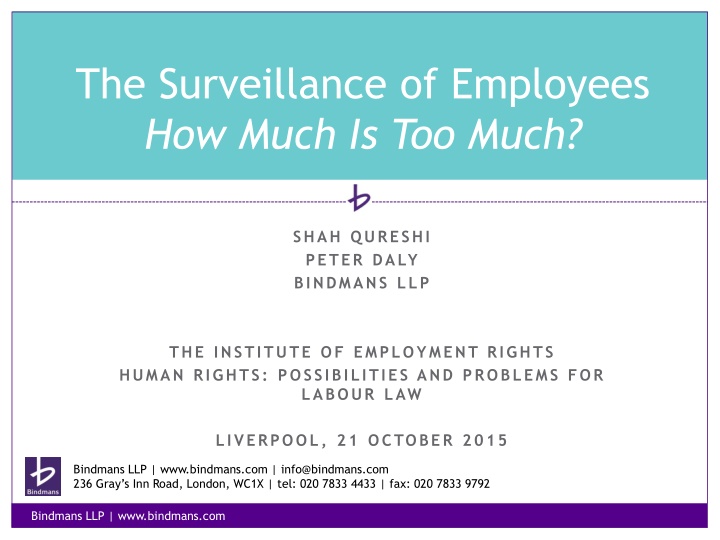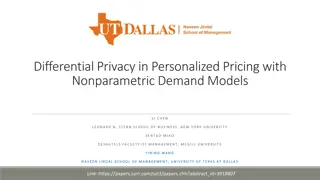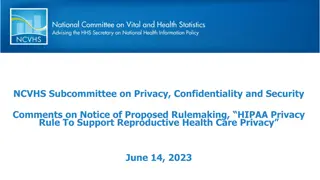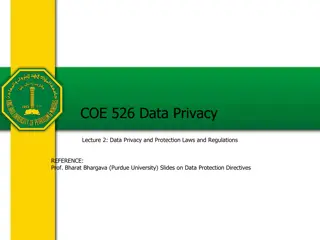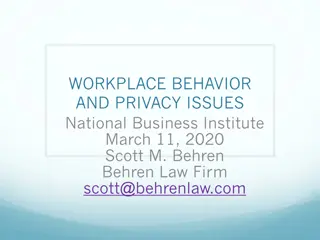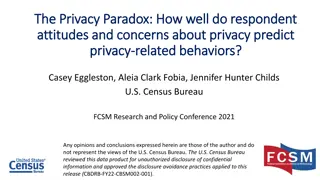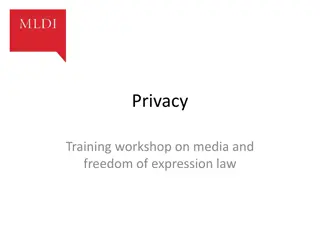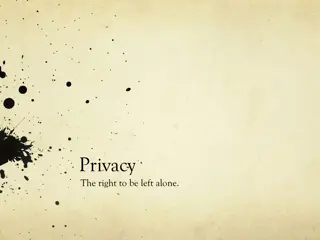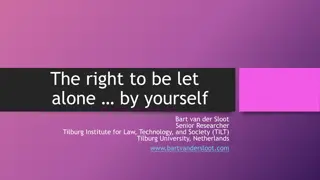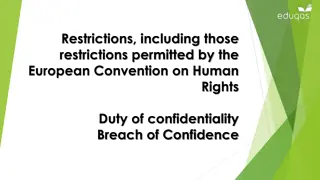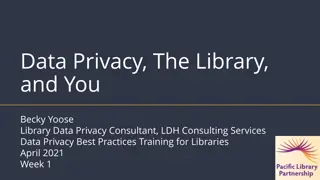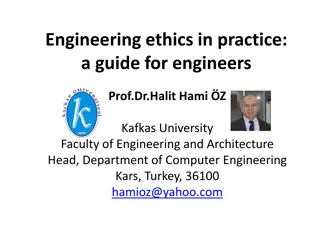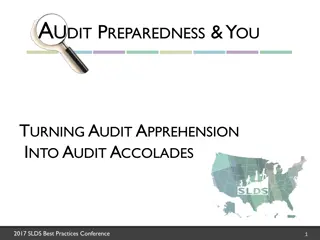The Surveillance of Employees: Balancing Control and Privacy
Surveillance of employees raises concerns regarding privacy and control in the workplace. Various types of surveillance, legal perspectives, and recent cases shed light on the complexities of monitoring employees. Understanding the implications and boundaries of surveillance is crucial for maintaining a respectful work environment.
Download Presentation

Please find below an Image/Link to download the presentation.
The content on the website is provided AS IS for your information and personal use only. It may not be sold, licensed, or shared on other websites without obtaining consent from the author.If you encounter any issues during the download, it is possible that the publisher has removed the file from their server.
You are allowed to download the files provided on this website for personal or commercial use, subject to the condition that they are used lawfully. All files are the property of their respective owners.
The content on the website is provided AS IS for your information and personal use only. It may not be sold, licensed, or shared on other websites without obtaining consent from the author.
E N D
Presentation Transcript
The Surveillance of Employees How Much Is Too Much? SHAH QURESHI PETER DALY BINDMANS LLP THE INSTITUTE OF EMPLOYMENT RIGHTS HUMAN RIGHTS: POSSIBILITIES AND PROBLEMS FOR LABOUR LAW LIVERPOOL, 21 OCTOBER 2015 Bindmans LLP | www.bindmans.com | info@bindmans.com 236 Gray s Inn Road, London, WC1X | tel: 020 7833 4433 | fax: 020 7833 9792 Bindmans LLP | www.bindmans.com
Defining Surveillance The types of surveillance The pace of change Sources of Law The European angle The UK angle Lessons for employees The Surveillance of Employees Institute of Employment Rights 21 October 2015 Bindmans LLP | www.bindmans.com
A Recent Case BWB v- Smith - UKEAT/0004/15 chipper training today and supposed to go home after it w***** supervisor told the trainer to keep us as long as he could the f****s don t even pay u for this s*** hard to sleep when the joys of another week at work are looming NOT" "ha what joy, 2 sleeps til back to my beloved work NOT" "good old bw cant wait to see all my friends again lol" "going to be a long day I hate my work" "that s why I hate my work for those reasons its not the work it s the people who ruin it nasty horrible human beings" "why are gaffers such p****s, is there some kind of book teaching them to be total w*****s" "on standby tonight so only going to get half p***** lol" "im on vodka and apple juice first time ive tried it no to shabby" Bindmans LLP | www.bindmans.com
BWB v- Smith BWB v- Smith - UKEAT/0004/15 Facebook posts predated the dismissal by 2 years. Posts came to light while company investigating Smith s grievances. Smith suspended when he arrived at mediation. Informed of suspension, escorted from premises, disciplinary and then summary dismissal. Game Retail v- Laws UKEAT/0188/14/DA Bindmans LLP | www.bindmans.com
Defining Surveillance Surveillance is a wide term which covers many different techniques. It literally means watching over or overseeing. Its French derivation suggests a persistent and close observation, often in secret, with some background purpose of control over or checking on another. Animals, for example, surveille their prey before pouncing on it. With the emergence of new technologies, sight has become more a metaphor for surveillance than a description of its practice. In the workplace it typically has the objective of monitoring workers to ensure that they perform in the desired fashion. Michael Ford, Surveillance and Privacy at Work (Institute of Employment Rights, 1998) Bindmans LLP | www.bindmans.com
Developments since 1998: The Quantified Self In the past, the methods of quantitative assessment were laborious and arcane. ... Now much of the data-gathering can be automated, and the record-keeping and analysis can be delegated to a host of simple Web apps. With new tracking systems popping up almost daily, we decided to create a Web site to track them. We called our project the Quantified Self. We don't have a slogan, but if we did it would probably be "Self-knowledge through numbers. Gary Wolf, Know Thyself: Tracking Every Facet of Life, from Sleep to Mood to Pain. Wired Magazine 22 June 2009 Bindmans LLP | www.bindmans.com
Self-Knowledge Through Numbers The Numbers The Source Health information: heart rate, movement, exercise Communication data: interaction with colleagues and clients Physical tasks Pedometers, heart monitors Email accounts; SMS and IM; Social Media Bespoke technologies: Amazon/Tesco Social Media Personal and political opinions Smart Phones Bespoke, cheap technology Voluntary collation by the subject Bindmans LLP | www.bindmans.com
Smart Phones and Social Media 334.4 million smartphones shipped worldwide in the first quarter of 2015 (1Q15), up 16.0% from the 288.3 million units in 1Q14 International Data Corporation, Worldwide Quarterly Mobile Phone Tracker, Retrieved 13 May 2015 936 million daily users internationally 60% of UK population use at least once a month (2010) Facebook.com/BBC Bindmans LLP | www.bindmans.com
Packaging Our Data You grant us a non-exclusive, transferable, sub- licensable, royalty-free, worldwide license to use any IP content that you post on or in connection with Facebook (IP License). This IP License ends when you delete your IP content or your account unless your content has been shared with others, and they have not deleted it. Facebook Terms of Service Paragraph 2.1 https://www.facebook.com/legal/terms Bindmans LLP | www.bindmans.com
Packaging Our Data When you use our services or view content provided by Google, we automatically collect and store certain information in server logs. This includes telephony log information like your phone number, calling-party number, forwarding numbers, time and date of calls, duration of calls, SMS routing information and types of calls When you use Google services, we may collect and process information about your actual location. We use various technologies to determine location, including IP address, GPS, and other sensors We may combine personal information from one service with information, including personal information, from other Google services We provide personal information to our affiliates or other trusted businesses or persons to process it for us, based on our instructions and in compliance with our Privacy Policy and any other appropriate confidentiality and security measures. Google Terms of Service Bindmans LLP | www.bindmans.com
Packaging Our Data Gesture Controls and Facial Recognition Your SmartTV is equipped with a camera that enables certain advanced features, including the ability to control and interact with your TV with gestures and to use facial recognition technology to authenticate your Samsung Account on your TV. Samsung Terms of Service http://www.samsung.com/uk/info/privacy-SmartTV.html Bindmans LLP | www.bindmans.com
So is this Surveillance? Ford: Surveillance is a wide term which covers many different techniques. It literally means watching over or overseeing. Its French derivation suggests a persistent and close observation, often in secret, with some background purpose of control over or checking on another But now: Don t have to watch the information in packaged; The information is not provided in secret; No background purpose: the collation of data is an end in itself Surveillance? Or Monitoring? Is there a distinction? Bindmans LLP | www.bindmans.com
The Nine ILO Workplace Monitoring Purposes (1996) To comply with law; To assist in selection for employment, training and promotion (NB: Three separate purposes); To ensure personal safety, personal security, quality control, customer service and the protection of property. ILO Code of Practice: The Protection of Workers Data (1996) http://www.ilo.org/wcmsp5/groups/public/@ed_protect/@protrav/@safework/docum ents/normativeinstrument/wcms_107797.pdf at page 13 of 38) Bindmans LLP | www.bindmans.com
The Nine ILO Purposes They are NOT: A reflection of the inherent need to check the performance of a worker. Simply a by-product of an employee integrated into an organisational structure . Necessary for the employment relationship to function. They ARE: Reactive. A situation has arisen (or is foreseen) and needs to be assessed. Bindmans LLP | www.bindmans.com
The New Purpose of Monitoring Non-Reactive Monitoring Nothing is wrong, but something might be better Worker knowledge through numbers: The era of the Quantified Worker. Close to ILO s Quality Control . But not the same. The collation of aworker s data without first identifying the specific purpose for which that data will be put to use. The Quantified Worker Bindmans LLP | www.bindmans.com
Good Monitoring vs Bad Monitoring Is there a distinction? Is it helpful? The Race Relations Act 1976 (Statutory Duties) Order 2001 The NHS Workforce Race Equality Scheme (WRES) Bindmans LLP | www.bindmans.com
Non-Reactive Monitoring Examples Steelcase: the movement of chairs Sociometric Solutions: Facial recognition in name badges Movement tracking by Amazon and Tesco (Non- Reactive?) Bindmans LLP | www.bindmans.com
The Hidden Complications of the Quantified Worker The Hypothetical Amazon Example Access to Medical Records Act 1988 Pre-notification of disability? The mutual duty of trust and confidence? The Hypothetical SocioMetric Solutions Example Predicting discriminatory behaviour? Bindmans LLP | www.bindmans.com
The Law Article 8 ECHR Article 8 Right to respect for private and family life 1. Everyone has the right to respect for his private and family life, his home and his correspondence. 2. There shall be no interference by a public authority with the exercise of this right except such as is in accordance with the law and is necessary in a democratic society in the interests of national security, public safety or the economic well-being of the country, for the prevention of disorder or crime, for the protection of health or morals, or for the protection of the rights and freedoms of others. Bindmans LLP | www.bindmans.com
The Law Article 8 ECHR in the Workplace Slivenko v Latvia (2004) 39 EHRR 24 (para 96) Private life was defined as: the network of personal, social and economic relations that make up the private life of every human being Niemietz v Germany [1992] ECHR 80, definition of the right to private life included the right to establish and develop relationships with other human beings, and have relationships of a professional or business nature. Bindmans LLP | www.bindmans.com
The Law Article 8 ECHR in the Workplace Halford v UK [1997] 24 ECHR 32breach of Article 8 when a police officer s telephone calls were tapped by her employer, who had previously assured her that she would not be monitored. Copland v United Kingdom [2007] ECHR 253. Monitoring of employee s emails breached A.8 where there was no IT policy and the employee was not told that they might be monitored. Bindmans LLP | www.bindmans.com
The Law Article 8 ECHR in the Workplace Public v Private employers Swansea v- Gayle Bindmans LLP | www.bindmans.com
The Law Data Protection Act 1998 City and County of Swansea v- Gayle UKEAT/0501/12 Filming of employee in public not a breach of private life Relevant if in employer s time As C had committed fraud, no expectation of privacy Employment Practices Code a helpful guide but not binding Particularly relevant to public employers, but of interest to private BUT fraud of public purse relevant here. Bindmans LLP | www.bindmans.com
The Law Data Protection Act 1998 City and County of Swansea v- Gayle UKEAT/0501/12 Filming of employee in public not a breach of private life Relevant if in employer s time As C had committed fraud, no expectation of privacy EPC a helpful guide but not binding Mainly relevant to public employers, of interest to private employers. But fraud of public purse relevant here. Bindmans LLP | www.bindmans.com
The Law Article 10 ECHR 1. Everyone has the right to freedom of expression. This right shall include freedom to hold opinions and to receive and impart information and ideas without interference by public authority and regardless of frontiers. This article shall not prevent States from requiring the licensing of broadcasting, television or cinema enterprises. 2. [Qualifications] Bindmans LLP | www.bindmans.com
The Law Article 10 ECHR in the Workplace Rubins v Latvia[2015] ECHR 2, a University Professor s dismissal was found to have breached Article 10 after he had provided emails criticising his employer University to the press Bindmans LLP | www.bindmans.com
The Law Article 10 ECHR in the Workplace Pay v the United Kingdom [2008] ECHR 1007, a Probation Officer was dismissed because of his involvement with a Sado-Masochist association. His employer had been anonymously directed towards the club s website, where it found photographs of the Claimant. The Claimant asserted that this dismissal breached various of his Convention rights, and was in particular his A.10 rights. The ECtHR found that this was without basis, and that the employer Probation Authority was entitled to hold the view that these activities were incompatible with his role as a probation officer and therefore to dismiss. Bindmans LLP | www.bindmans.com
The Law Article 10 ECHR in the Workplace Applies Whistleblowing provisions more extensive Limited application on monitoring thus far. Bindmans LLP | www.bindmans.com
The Law Data Protection Act 1998 Section 1 Definitions of Data, Sensitive Personal Data, Processing. Information Commissioner s Employment Practices Code: activities that set out to collect information about workers by keeping them under some form of observation, normally with a view to checking their performance or conduct. This could be done either directly, indirectly, perhaps by examining their work output, or by electronic means. Bindmans LLP | www.bindmans.com
The Law Data Protection Act 1998 Employment Practices Code (Continued): The Data Protection Act does not prevent monitoring. Indeed in some cases monitoring might be necessary to satisfy its requirements. However, any adverse impact of monitoring on individuals must be justified by the benefits to the employer and others. Bindmans LLP | www.bindmans.com
The Law Data Protection Act 1998 Impact Assessments: identifying clearly the purpose(s) behind the monitoring arrangement and the benefits it is likely to deliver identifying any likely adverse impact of the monitoring arrangement considering alternatives to monitoring or different ways in which it might be carried out taking into account the obligations that arise from monitoring judging whether monitoring is justified. Bindmans LLP | www.bindmans.com
The Law Data Protection Act 1998 Subject Access Requests (limitations): Self Policed Limited to data which falls to be disclosed: is the Data Subject identifiable? Statutory Exemptions (legal privilege) Enforcement Bindmans LLP | www.bindmans.com
The Law Data Protection Act 1998 Subject Access Requests (limitations): Self Policed Limited to data which falls to be disclosed: is the Data Subject identifiable? Statutory Exemptions (legal privilege) Enforcement Bindmans LLP | www.bindmans.com
The Law Data Protection Act 1998 Employment Practices Code (Continued): City and County of Swansea v- Gayle UKEAT/0501/12 EPC a helpful guide but not binding Bindmans LLP | www.bindmans.com
The Law Regulation of Investigatory Powers Act 2000 s.1(2): It shall be an offence for a person (a)intentionally and without lawful authority, and (b)otherwise than in circumstances in which his conduct is excluded by subsection (6) from criminal liability under this subsection, to intercept, at any place in the United Kingdom, any communication in the course of its transmission by means of a private telecommunication system. Bindmans LLP | www.bindmans.com
The Law Regulation of Investigatory Powers Act 2000 s.1(3): Any interception of a communication which is carried out at any place in the United Kingdom by, or with the express or implied consent of, a person having the right to control the operation or the use of a private telecommunication system shall be actionable at the suit or instance of the sender or recipient, or intended recipient, of the communication if it is without lawful authority and is either (a)an interception of that communication in the course of its transmission by means of that private system; or (b)an interception of that communication in the course of its transmission, by means of a public telecommunication system, to or from apparatus comprised in that private telecommunication system. Bindmans LLP | www.bindmans.com
The Law Regulation of Investigatory Powers Act 2000 Unlawful Activity by employer: Interception Of telephone calls (if phone system connect to public system): or Emails (if computer system connect to public system [internet rather than intranet] section 67(7), RIPA 2000 Actionable by employee, recipient or intended recipient Bindmans LLP | www.bindmans.com
The Law Regulation of Investigatory Powers Act 2000 But only actionable if it is unlawful : Warrant System Consent Proper IT policies are deemed consent Effective policies remove the risk (cf Copland v UK Article 8). Bindmans LLP | www.bindmans.com
The Law Regulation of Investigatory Powers Act 2000 But only actionable if it is unlawful : Warrant System Consent Proper IT policies are deemed consent Effective policies remove the risk (cf Copland v UK Article 8). Bindmans LLP | www.bindmans.com
The Law Telecommunications Regulations 2000 Lawful for businesses to monitor or record communications without consent to: Ascertain compliance with the regulatory or self-regulatory practices or procedures relevant to the business. Ascertain or demonstrate standards which are or ought to be achieved by persons using the system. Prevent or detect crime. Investigate or detect the unauthorised use of the telecommunications system. Ensure the effective operation of the system. (Regulation 3, Telecommunications Regulations 2000.) Bindmans LLP | www.bindmans.com
The Law Telecommunications Regulations 2000 Regulation 3 also allows businesses to monitor, but not record without consent for the purposes of: Determining whether the communications are relevant to the business. Monitoring communications to a confidential anonymous counselling or support helpline. Bindmans LLP | www.bindmans.com
The Law Telecommunications Regulations 2000 Big lacuna in regulations! Ascertain or demonstrate standards which are or ought to be achieved by persons using the system. Regulation 3(a)(i)(cc), Telecommunications Regulations 2000. Bindmans LLP | www.bindmans.com
The Law Chand v- Commissioner of Police for the Metropolis Telecommunications Regulations M had to demonstrate that monitoring: r.3(2)(a): "solely" to monitor communications relevant to the system controller's business. It also had to r.3(2)(c): all reasonable efforts had been made to inform users of the system that communications might be intercepted. Bindmans LLP | www.bindmans.com
The Law Chand v- Commissioner of Police for the Metropolis RIPA The existence of consent under s.3 satisfied by an express term in a contract of employment setting out an employee's consent to the possibility of monitoring. Although there was no such express provision in the instant case, M had reminded police officers that their communications might be monitored or recorded. However, s.3(2) of the Act required that interceptions had been authorised under Part II, and the authorisations obtained in the instant case specifically stated that no party to the monitoring and recording had consented. Accordingly, the interceptions were unlawful. Bindmans LLP | www.bindmans.com
Overview If Basic criteria satisfied IT/Email policy (A.8/Copland) Impact Assessment (DPA/Employment Practices Code) Consent a term in the employment contract (DPA/RIPA/Telecommunications Regs) Then very few limits at all. Bindmans LLP | www.bindmans.com
Problems from an Employee Perspective Avenues to Restrict Monitoring by the Employee are almost Meaningless Only Consent is a positive act by the Employee (and the Impact Assessment may in fact be unknown to the Employee at all) Chandmakes clear that it can be contained in an employment contract Cf Working Time Opt Outs: Not within the contract itself Ability to withdraw consent Bindmans LLP | www.bindmans.com
Problems from an Employee Perspective Regulation is outdated DPA 1998, RIPA and Tel Regs 2000. No concepts of non-active monitoring. No concept of the Quantified Worker. No capacity for worker to withdraw from the monitoring. No allowance for imbalance of bargaining positions. Bindmans LLP | www.bindmans.com
So How Much is Too Much? Meet the basic requirements, and employers can monitor as much as they like! Bindmans LLP | www.bindmans.com
Shah Qureshi Partner, Head of Employment and Professional Discipline Bindmans LLP s.qureshi@bindmans.com Peter Daly Solicitor, Employment and Professional Discipline Bindmans LLP p.daly@bindmans.com The Surveillance of Employees Institute of Employment Rights 21 October 2015 Bindmans LLP | www.bindmans.com
